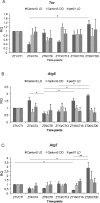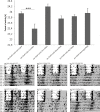TOR signaling pathway and autophagy are involved in the regulation of circadian rhythms in behavior and plasticity of L2 interneurons in the brain of Drosophila melanogaster
- PMID: 28196106
- PMCID: PMC5308838
- DOI: 10.1371/journal.pone.0171848
TOR signaling pathway and autophagy are involved in the regulation of circadian rhythms in behavior and plasticity of L2 interneurons in the brain of Drosophila melanogaster
Abstract
Drosophila melanogaster is a common model used to study circadian rhythms in behavior and circadian clocks. However, numerous circadian rhythms have also been detected in non-clock neurons, especially in the first optic neuropil (lamina) of the fly's visual system. Such rhythms have been observed in the number of synapses and in the structure of interneurons, which exhibit changes in size and shape in a circadian manner. Although the patterns of these changes are known, the mechanism remains unclear. In the present study, we investigated the role of the TOR signaling pathway and autophagy in regulating circadian rhythms based on the behavior and structural plasticity of the lamina L2 monopolar cell dendritic trees. In addition, we examined the cyclic expression of the TOR signaling pathway (Tor, Pi3K class 1, Akt1) and autophagy (Atg5 and Atg7) genes in the fly's brain. We observed that Tor, Atg5 and Atg7 exhibit rhythmic expressions in the brain of wild-type flies in day/night conditions (LD 12:12) that are abolished in per01 clock mutants. The silencing of Tor in per expressing cells shortens a period of the locomotor activity rhythm of flies. In addition, silencing of the Tor and Atg5 genes in L2 cells disrupts the circadian plasticity of the L2 cell dendritic trees measured in the distal lamina. In turn, silencing of the Atg7 gene in L2 cells changes the pattern of this rhythm. Our results indicate that the TOR signaling pathway and autophagy are involved in the regulation of circadian rhythms in the behavior and plasticity of neurons in the brain of adult flies.
Conflict of interest statement
The authors have declared that no competing interests exist.
Figures





References
-
- Pyza E, Górska-Andrzejak J. External and internal inputs affecting plasticity of dendrites and axons of the fly's neurons. Acta Neurobiol Exp (Wars). 2008;68(2):322–33. - PubMed
-
- Górska-Andrzejak J, Damulewicz M, Pyza E. Circadian changes in neuronal networks. Curr Opin Insect Sci. 2015. February;7:76–81. - PubMed
MeSH terms
Substances
LinkOut - more resources
Full Text Sources
Other Literature Sources
Molecular Biology Databases
Research Materials
Miscellaneous

